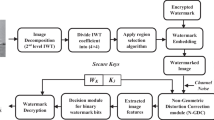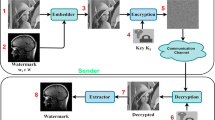Abstract
Recently the data hiding techniques on DNA sequence have attracted interest for DNA authentication and high-capacity DNA storage. However, since DNA sequence represents the primary information that directs the functions of organism, it is necessary for distortion-free DNA data hiding, so-called reversible DNA data hiding, with high capacity, low change rate of nucleotide bases, biological preservation, and reversibility. In this paper, we address two approaches of reversible DNA data hiding using multiple difference expansions. Reversible DNA data hiding should consider the string structure of a DNA sequence, the biological functionality, the efficient recovery, and the optimal embedding capacity. Our method converts the string sequence of four characters (A,T,C,G) of noncoding DNA sequences into decimal-coded values and embeds the watermark into coded value sequence using two approaches; DE-based multiple bits embedding (DE-MBE) using pairs of neighboring values and consecutive DE-MBE (CDE-MBE) using previous embedded coded values as the current estimated ones. Two approaches use comparison searching to prevent false start codons that produce false coding regions (exons) and embed multiple bits for maximal expandability of differences within the range of coded values. From experimental results using bacterial and archaeal sequences, we verified that our CDE-MBE have a higher embedding capacity of 1.13times~9.03times than conventional methods, and produce no false start codons, verify the security by secure numerical coding and recover the host sequence perfectly without a reference sequence. In particular, CDE-MBE has an embedding capacity that is two times greater than that of DE-MBE.













Similar content being viewed by others
References
Babatunde OO (2011) Deoxyribonucleic acid (DNA) as a hypothetical information hiding medium: DNA mimics basic information security protocol. J Eng Technol Res 3(5):148–154
Balado F (2013) Capacity of DNA data embedding under substitution mutations. IEEE Trans Inf Theory 59(2):928–941
Borda M, Tornea O (2010) DNA secret writing techniques. 8th International Conference on Communications (COMM), p. 451-456
Chen T (2007) A novel biology-based reversible data hiding fusion scheme. Front Algorithm (FAW) Lect Notes Comput Sci 4613:84–95
Clelland CT, Risca V, Bancroft C (1999) Hiding messages in DNA microdots. Nature 399:533–534
Coltuc D (2011) Improved embedding for prediction-based reversible watermarking. IEEE Trans Inf Forensic Secur 6(3):873–882
Cox JPL (2001) Long-term data storage in DNA. Trends Biotechnol 19(7):247–250
Fu J, Zhang W, Yu N, Ma G, Tang Q (2014) Fast tamper location of batch DNA sequences based on reversible data hiding. 7th International Conference on Biomedical Engineering and Informatics (BMEI), p 868-872
Gibson DG, Benders GA, Andrews-Pfannkoch C, Denisova EA, Baden-Tillson H, Zaveri J, Stockwell TB, Brownley A, Thomas DW, Algire MA, Merryman C, Young L, Noskov VN, Glass JI, Venter JC, Hutchison CA III., Smith HO (2008) Complete Chemical Synthesis, Assembly, and Cloning of a Mycoplasma genitalium Genome. Science 319(5867):1215–1220
Gibson DG, Glass JI, Lartigue C, Noskov VN, Chuang R-Y, Algire MA, Benders GA, Montague MG, Ma L, Moodie MM, Merryman C, Vashee S, Krishnakumar R, Assad-Garcia N, Andrews-Pfannkoch C, Denisova EA, Young L, Qi Z-Q, Segall-Shapiro TH, Calvey CH, Parmar PP, Hutchison CA III, Smith HO, Venter JC (2010) Creation of a bacterial cell controlled by a chemically synthesized genome. Science 329(5987):52–56
Goldman N, Bertone P, Chen S, Dessimoz C, LeProust EM, Sipos B, Birney E (2013) Towards practical high-capacity, low-maintenance information storage in synthesized DNA. Nature 494:77–80
Heider D, Barnekow A (2007) DNA-based watermarks using the DNA-Crypt algorithm. BMC Bioinf 8(176)
Heider D, Barnekow A (2008) DNA Watermarks - a proof of concept. BMC Bioinf 9(40)
Heider D, Barnekow A (2009) DNA watermarks in non-coding regulatory sequences. BMC Bioinf 2(125)
Heider D, Barnekow A (2011) DNA Watermarking: challenging perspectives for biotechnological applications. Curr Bioinforma 6(3):375–382
Hu Y, Lee H-K, Li J (2007) DE-based reversible data hiding with improved overflow location map. IEEE Trans Circ Syst Video Technol 19(2):250–260
Hu X, Zhang W, Li X, Yu N (2015) Minimum rate prediction and optimized histograms modification for reversible data hiding. IEEE Trans Inf Forensic Secur 10(3):653–664
Huang Y-H, Chang C-C, Wu C-Y (2014) A DNA-based data hiding technique with low modification rates. Multimed Tools Appl 70(3):1439–1451
Jupiter D, Ficht T, Samuel J, Qin Q-M, Figueiredo P (2010) DNA watermarking of infectious agents: progress and prospects. PLoS Pathog 6(6):e1000950. https://doi.org/10.1371/journal.ppat.1000950
Lee S-H (2014) DNA sequence watermarking based on random circular angle. Digital Signal Process 25:173–189
Lee S-H (2014) DWT based coding DNA watermarking for DNA copyright protection. Inf Sci 273:263–286
Lieff J (2012) mind and molecular genetics in the neuron 2: new genetic landscape. http://jonlieffmd.com/blog/mind-and-molecular-genetics-in-the-neuron-2-new-genetic-landscape-2
Liss M, Daubert D, Brunner K, Kliche K, Hammes U, Leiherer A, Wagner R (2012) Embedding permanent watermarks in synthetic genes. PLoS One 7(8):e42465. https://doi.org/10.1371/journal.pone.0042465
Ma G, Tang Q, Zhang W, Yu N (2013) Tamper restoration on DNA sequences based on reversible data hiding. Int Conf Biomed Eng Inf (BMEI) 484–489:1–13
Ou B, Li X, Zhao Y, Ni R, Shi Y-Q (2013) Pairwise prediction-error expansion for efficient reversible data hiding. IEEE Trans Image Process 22(12):5010–5021
Risca VI (2001) DNA-based steganography. Cryptologia 25(1):37–49
Shimanovsky B, Feng J, Potkonjak M (2002) Hiding data in DNA. Procs. of the 5th Intl. Workshop in Information Hiding, p 373-386
Shiu HJ, Ng KL, Fang JF, Lee RCT, Huan CH (2010) Data hiding methods based upon DNA sequences. Inf Sci 180(11):2196–2208
Singh AK (2017) Improved Hybrid Technique for Robust and Imperceptible Multiple Watermarking using digital Images. Multimed Tools Appl 76(6):8881–8900
Tang Q, Ma G, Zhang W, Yu N (2014) Reversible data hiding for DNA sequences and its applications. Int J Dig Crime Forensic Arch 6(4):1–13
Tian J (2003) Reversible data embedding using a difference expansion. IEEE Trans Circ Syst Video Technol 13(8):890–896
Tulpan D, Regoui C, Durand G, Belliveau L, Léger S (2013) HyDEn: a hybrid steganocryptographic approach for data encryption using randomized error-correcting DNA codes. BioMed Res Int 634832
Wang Z, Zhao X, Wang H, Cui G (2013) Information hiding based on DNA steganography. 4th IEEE International Conference on Software Engineering and Service Science (ICSESS), p. 946-949
Wang J, Ni J, Zhang X, Shi Y-Q (2017) Rate and distortion optimization for reversible data hiding using multiple histogram shifting. IEEE Trans Cybern 47(2):315–326
Wong PC, Wong KK, Foote HP (2003) Organic data memory using the DNA approach. Commun ACM 46(1)
Yamamoto M, Kashiwamura S, Ohuchi A, Furukawa M (2008) Large-scale DNA memory based on the nested PCR. Nat Comput 7(3):335–346
Zear A, Singh AK, Kumar P (2016) A proposed secure multiple watermarking technique based on DWT, DCT and SVD for application in medicine. Multimed Tools Appl 1-20. Online first published
Acknowledgements
This research was supported by Basic Science Research Program through the National Research Foundation of Korea (NRF) funded by the Ministry of Education, Science and Technology (NRF-NRF-2016R1D1A3B03931003 and NRF-2017R1A2B2012456) and also supported by Brain Busan (BB21) project.
Author information
Authors and Affiliations
Corresponding author
Rights and permissions
About this article
Cite this article
Lee, SH., Lee, EJ., Hwang, WJ. et al. Reversible DNA data hiding using multiple difference expansions for DNA authentication and storage. Multimed Tools Appl 77, 19499–19526 (2018). https://doi.org/10.1007/s11042-017-5379-1
Received:
Revised:
Accepted:
Published:
Issue Date:
DOI: https://doi.org/10.1007/s11042-017-5379-1




